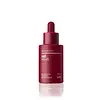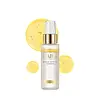What's inside
What's inside
 Key Ingredients
Key Ingredients

 Benefits
Benefits

 Concerns
Concerns

 Ingredients Side-by-side
Ingredients Side-by-side

Water
Skin ConditioningButylene Glycol
HumectantGlycerin
HumectantBetaine
HumectantHamamelis Virginiana Leaf Extract
Skin ConditioningPunica Granatum Fruit Extract
AntioxidantNiacinamide
SmoothingPEG-60 Hydrogenated Castor Oil
EmulsifyingDioscorea Villosa Root Extract
Skin ConditioningVaccinium Angustifolium Fruit Extract
Skin ProtectingLycium Chinense Fruit Extract
AntioxidantRubus Idaeus Fruit Extract
AstringentEuterpe Oleracea Fruit Extract
1,2-Hexanediol
Skin ConditioningAlcohol
AntimicrobialAllantoin
Skin ConditioningCarbomer
Emulsion StabilisingArginine
MaskingDipotassium Glycyrrhizate
HumectantBoswellia Serrata Resin Extract
SmoothingPrunus Amygdalus Dulcis Seed Extract
Skin ConditioningSodium Hyaluronate
HumectantAdenosine
Skin ConditioningPhenoxyethanol
PreservativeDisodium EDTA
Jasminum Officinale Oil
MaskingLecithin
EmollientLepidium Sativum Sprout Extract
Skin ConditioningWater, Butylene Glycol, Glycerin, Betaine, Hamamelis Virginiana Leaf Extract, Punica Granatum Fruit Extract, Niacinamide, PEG-60 Hydrogenated Castor Oil, Dioscorea Villosa Root Extract, Vaccinium Angustifolium Fruit Extract, Lycium Chinense Fruit Extract, Rubus Idaeus Fruit Extract, Euterpe Oleracea Fruit Extract, 1,2-Hexanediol, Alcohol, Allantoin, Carbomer, Arginine, Dipotassium Glycyrrhizate, Boswellia Serrata Resin Extract, Prunus Amygdalus Dulcis Seed Extract, Sodium Hyaluronate, Adenosine, Phenoxyethanol, Disodium EDTA, Jasminum Officinale Oil, Lecithin, Lepidium Sativum Sprout Extract
Water
Skin ConditioningDipropylene Glycol
HumectantNeopentyl Glycol Diheptanoate
EmollientGlycereth-26
Humectant1,2-Hexanediol
Skin ConditioningNiacinamide
SmoothingHydroxyethyl Urea
HumectantPersea Gratissima Oil
Skin ConditioningButylene Glycol
HumectantBetaine
HumectantTuber Magnatum Extract
Skin ConditioningGlycerin
HumectantHelianthus Annuus Seed Oil
EmollientSorbitol
HumectantDipotassium Glycyrrhizate
HumectantDisodium EDTA
Tocopheryl Acetate
AntioxidantAdenosine
Skin ConditioningBifida Ferment Lysate
Skin ConditioningGlycine Soja Oil
EmollientSodium Palmitoyl Proline
Skin ConditioningArginine
MaskingBellis Perennis Flower Extract
Skin ConditioningCarbomer
Emulsion StabilisingFreesia Refracta Extract
Skin ConditioningHouttuynia Cordata Extract
Skin ConditioningLeontopodium Alpinum Extract
Skin ConditioningLilium Candidum Flower Extract
Skin ConditioningMorus Alba Bark Extract
Skin ConditioningNelumbo Nucifera Flower Extract
Skin ConditioningPanax Ginseng Root Extract
EmollientSaussurea Involucrata Extract
HumectantPotassium Sorbate
PreservativeAvena Sativa Kernel Extract
AbrasiveHydrolyzed Hyaluronic Acid
HumectantOcimum Basilicum Flower/Leaf/Stem Extract
TonicSalvia Hispanica Seed Extract
EmollientBixa Orellana Seed Oil
EmollientTocopherol
AntioxidantNymphaea Alba Flower Extract
Skin ConditioningParfum
MaskingLinalool
PerfumingHexyl Cinnamal
PerfumingLimonene
PerfumingCitronellol
PerfumingWater, Dipropylene Glycol, Neopentyl Glycol Diheptanoate, Glycereth-26, 1,2-Hexanediol, Niacinamide, Hydroxyethyl Urea, Persea Gratissima Oil, Butylene Glycol, Betaine, Tuber Magnatum Extract, Glycerin, Helianthus Annuus Seed Oil, Sorbitol, Dipotassium Glycyrrhizate, Disodium EDTA, Tocopheryl Acetate, Adenosine, Bifida Ferment Lysate, Glycine Soja Oil, Sodium Palmitoyl Proline, Arginine, Bellis Perennis Flower Extract, Carbomer, Freesia Refracta Extract, Houttuynia Cordata Extract, Leontopodium Alpinum Extract, Lilium Candidum Flower Extract, Morus Alba Bark Extract, Nelumbo Nucifera Flower Extract, Panax Ginseng Root Extract, Saussurea Involucrata Extract, Potassium Sorbate, Avena Sativa Kernel Extract, Hydrolyzed Hyaluronic Acid, Ocimum Basilicum Flower/Leaf/Stem Extract, Salvia Hispanica Seed Extract, Bixa Orellana Seed Oil, Tocopherol, Nymphaea Alba Flower Extract, Parfum, Linalool, Hexyl Cinnamal, Limonene, Citronellol
 Reviews
Reviews

Ingredients Explained
These ingredients are found in both products.
Ingredients higher up in an ingredient list are typically present in a larger amount.
1,2-Hexanediol is a synthetic liquid and another multi-functional powerhouse.
It is a:
- Humectant, drawing moisture into the skin
- Emollient, helping to soften skin
- Solvent, dispersing and stabilizing formulas
- Preservative booster, enhancing the antimicrobial activity of other preservatives
Adenosine is in every living organism. It is one of four components in nucleic acids that helps store our DNA.
Adenosine has many benefits when used. These benefits include hydrating the skin, smoothing skin, and reducing wrinkles. Once applied, adenosine increases collagen production. It also helps with improving firmness and tissue repair.
Studies have found adenosine may also help with wound healing.
In skincare products, Adenosine is usually derived from yeast.
Learn more about AdenosineArginine is an amino acid that is important for human development. Your body uses is it to produce hair keratin and skin collagen.
As a cosmetic ingredient, Arginine has antioxidant properties and can also help repair damaged skin. This ingredient is derived either synthetically or from animals.
Arginine isn't fungal acne safe when used in the presence of other lipids (fats, fatty acids, oils, esters, etc). Oils and fats occur naturally within the skin, so take caution when using Arginine if you're prone to fungal acne.
Learn more about ArginineBetaine is a common humectant (a substance that promotes retention of moisture). It's known to be gentle on the skin and can help balance hydration.
This ingredient is best for improving hydration and soothing irritated skin. Studies also show it helps even out skin tone.
Fun fact: Betaine is naturally created in the skin and body. The kind found within cosmetic products can be either plant-derived or synthetic.
Another name for betaine is trimethylglycine.
Learn more about BetaineButylene Glycol (or BG) is used within cosmetic products for a few different reasons:
Overall, Butylene Glycol is a safe and well-rounded ingredient that works well with other ingredients.
Though this ingredient works well with most skin types, some people with sensitive skin may experience a reaction such as allergic rashes, closed comedones, or itchiness.
Learn more about Butylene GlycolCarbomer is a polymer of acrylic acid. Its main role is to create a gel consistency.
A high amount of carbomer can cause pilling or balling up of products. Don't worry, most products contain 1% or less of carbomer.
Dipotassium Glycyrrhizate comes from licorice root.
Extracts of licorice have demonstrated to have antibacterial, anti‐inflammatory, antiviral, antioxidant properties.
One component, glabridin, has extra potent antioxidant and soothing properties. It has also been found to block pigmentation from UVB rays in guinea pigs.
Licorice Root also contains a flavonoid. Flavonoids are a natural substance from in plants. Flavonoids also have antioxidant properties.
Another component, glycyrrhizin, has been found to have anti-inflammatory and antimicrobial benefits. This may make licorice root extract effective at treating acne. However, more research is needed to support this.
Liquiritin is one of the flavone compounds found in licorice. It has been found to help lighten skin by preventing tyrosinase from reacting with tyrosine. When the two react, protein is converted to melanin. Melanin is the substance in your body that gives your features pigmentation.
Licorice root is native to Southern Europe and Asia. It has been used in traditional Chinese medicine to help with respiratory issues.
Learn more about Dipotassium GlycyrrhizateDisodium EDTA plays a role in making products more stable by aiding other preservatives.
It is a chelating agent, meaning it neutralizes metal ions that may be found in a product.
Disodium EDTA is a salt of edetic acid and is found to be safe in cosmetic ingredients.
Learn more about Disodium EDTAGlycerin is already naturally found in your skin. It helps moisturize and protect your skin.
A study from 2016 found glycerin to be more effective as a humectant than AHAs and hyaluronic acid.
As a humectant, it helps the skin stay hydrated by pulling moisture to your skin. The low molecular weight of glycerin allows it to pull moisture into the deeper layers of your skin.
Hydrated skin improves your skin barrier; Your skin barrier helps protect against irritants and bacteria.
Glycerin has also been found to have antimicrobial and antiviral properties. Due to these properties, glycerin is often used in wound and burn treatments.
In cosmetics, glycerin is usually derived from plants such as soybean or palm. However, it can also be sourced from animals, such as tallow or animal fat.
This ingredient is organic, colorless, odorless, and non-toxic.
Glycerin is the name for this ingredient in American English. British English uses Glycerol/Glycerine.
Learn more about GlycerinNiacinamide is a multitasking form of vitamin B3 that strengthens the skin barrier, reduces pores and dark spots, regulates oil, and improves signs of aging.
And the best part? It's gentle and well-tolerated by most skin types, including sensitive and reactive skin.
You might have heard of "niacin flush", or the reddening of skin that causes itchiness. Niacinamide has not been found to cause this.
In very rare cases, some individuals may not be able to tolerate niacinamide at all or experience an allergic reaction to it.
If you are experiencing flaking, irritation, and dryness with this ingredient, be sure to double check all your products as this ingredient can be found in all categories of skincare.
When incorporating niacinamide into your routine, look out for concentration amounts. Typically, 5% niacinamide provides benefits such as fading dark spots. However, if you have sensitive skin, it is better to begin with a smaller concentration.
When you apply niacinamide to your skin, your body converts it into nicotinamide adenine dinucleotide (NAD). NAD is an essential coenzyme that is already found in your cells as "fuel" and powers countless biological processes.
In your skin, NAD helps repair cell damage, produce new healthy cells, support collagen production, strengthen the skin barrier, and fight environmental stressors (like UV and pollution).
Our natural NAD levels start to decline with age, leading to slower skin repair, visible aging, and a weaker skin barrier. By providing your skin niacinamide, you're recharging your skin's NAD levels. This leads to stronger, healthier, and younger looking skin.
Another name for vitamin B3 is nicotinamide. This vitamin is water-soluble and our bodies don't store it. We obtain Vitamin B3 from either food or skincare. Meat, fish, wheat, yeast, and leafy greens contain vitamin B3.
The type of niacinamide used in skincare is synthetically created.
Learn more about NiacinamideWater. It's the most common cosmetic ingredient of all. You'll usually see it at the top of ingredient lists, meaning that it makes up the largest part of the product.
So why is it so popular? Water most often acts as a solvent - this means that it helps dissolve other ingredients into the formulation.
You'll also recognize water as that liquid we all need to stay alive. If you see this, drink a glass of water. Stay hydrated!
Learn more about Water